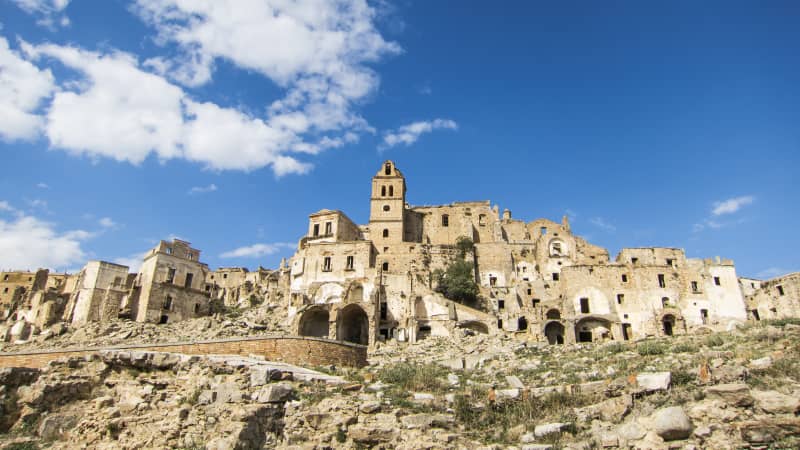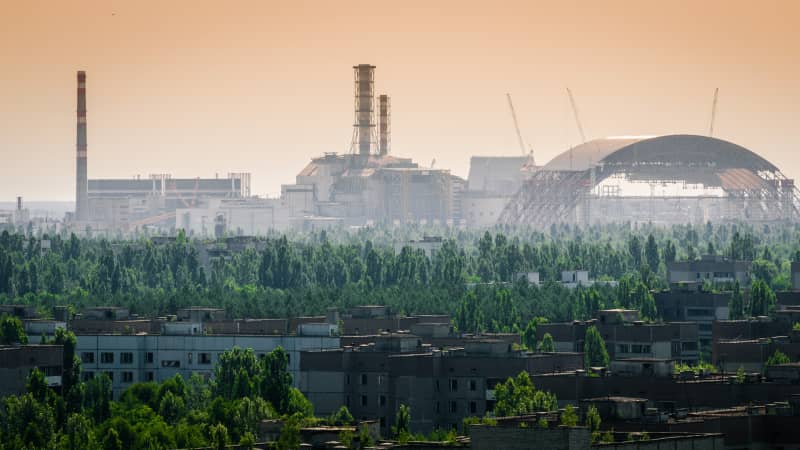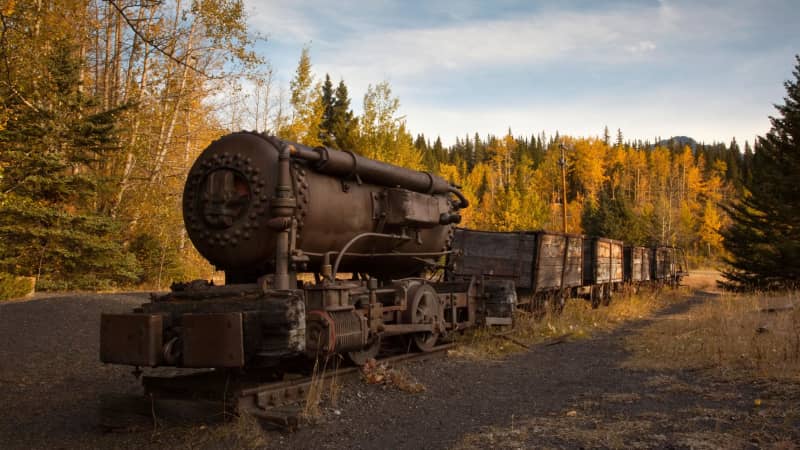(CNN) — Once thriving spots, these villages, towns and cities now stand abandoned. Their empty buildings, streets and even cars left for nature to reclaim over the years.
Whether destroyed during war, evacuated for ammunition practice or cast aside after nearby precious metals and minerals turned out to be in short supply, here are some of the world’s most fascinating abandoned towns and cities.
Oradour-Sur-Glane, France

The village of Oradour-sur-Glane was the site of a horrific massacre during World War II.
Adobe Stock
The ruins of this former fishing village serve as a stark reminder of the horrors of World War II.
Oradour-Sur-Glane has been left relatively untouched since June 10, 1944, when much of its population was massacred by the Waffen SS, a military branch of the Nazi Party’s SS organization.
During the atrocity, men were shot and killed in barns, while women and children were also murdered when the church they were locked in was blown up. Survivors were gunned down as they fled.
Wartime leader Charles De Gaulle later decided that Oradour-Sur-Glane should be left as a testament to Nazi cruelty.
A new village with a memorial museum, open since 1999, has been built near by.
Wharram Percy, United Kingdom

Wharram Percy has been empty for 500 years.
Adobe Stock
Arguably England’s best known deserted medieval village, Wharram Percy, found in the beautiful Yorkshire Wolds, was once home to two stunning manor houses and a church.
The latter is the only building still standing, but the foundations of the houses, built by the noble Percy family, can still be seen, as can those of the surrounding peasant homes.
The village population dwindled for years as locals moved away due to a shift towards sheep farming. It was abandoned not long after 1500, when the last remaining residents were evicted.
Belchite, Spain

Belchite has been left relatively untouched since it was destroyed in the Spanish Civil War.
Adobe Stock
On the front line between Republican and fascist forces during the Spanish Civil War, Belchite was the center of a weeks-long siege between August and September 1937, before finally falling to General Francisco Franco’s forces in 1939.
Left much as it was then, the tiny village located south of Zaragoza in northeastern Spain stands as a memorial to those who fell, the ruins of its stunning church particularly affecting.
The deserted spot, where a new village, built in 1939, can be found close by, makes for an interesting day trip from Zaragoza.
Craco, Italy

Craco has been a ghost town since the late 20th century.
Adobe Stock
Located in the far south of Italy, Craco’s vertiginous location and spectacular architecture make it one of the most visually arresting abandoned towns in the world.
Residents began to leave after a series of landslides caused by sewage and water works in the 1960s, and Craco was left completely deserted in the wake of the Irpinia earthquake in 1980.
Since then, not only has the ghost town pulled in thousands of tourists, its also become an popular filming location, featuring in movies like 2008 James Bond offering “Quantum of Solace.”
Grand-Bassam, Ivory Coast

Grand Bassam is filled with derelict buildngs like this old colonial house.
Alamy
While Grand-Bassam still has a thriving population, many of its most striking buildings have been empty for years.
Once the French colonial capital of Côte d’Ivoire, the resort town is now a UNESCO World Heritage Site, with noted structures such as the old Post Office, Central African Bank and the Hotel de France.
The history of Grand-Bassam dates back much further than the French. The Nzema people, also known as Ndenye or Apollonians, of the Ivory Coast are thought to have lived here from the 15th century, growing the town into a lively port and fishing village before the arrival of colonists.
Kolmanskop, Namibia

Kolmanskop in Namibia was one of the richest towns in Africa years before it was abandoned.
Adobe Stock
With many of its buildings half-submerged in sand, Kolmanskop stands as an eerie reminder of what was once a buzzing town in the heart of the Namib desert.
Founded after local worker Zacharias Lewala discovered diamonds here in 1908, it saw a huge influx of German miners and became a bustling hub before it was finally abandoned in 1956.
Built to mimic a German town, Kolmanskop had a ballroom, a casino and even a tram system.
Tourists come here to witness how the desert has reclaimed the buildings, with the entire town slowly disappearing forever beneath the sand.
Bodie, California

Discarded cars lie rusting in California ghost town Bodie.
Adobe Stock
Perhaps the most famous of the Wild West boomtowns of the late 19th century, Bodie’s population grew from a handful of prospectors to 10,000 people in the late 1870s.
With rich seams of gold to be found, people flocked to the Californian town, positioned near the Nevada border, to make their fortune, with an incredible 65 saloons, a Wells Fargo bank and even a Chinatown replete with Taoist temple.
But Bodie’s appeal had faded by the early 20th century, as other boomtowns rose to prominence, and its population fell to just 120 in 1920.
The deserted town’s well-preserved buildings make it a memorable stop off on Wild West tours today.
Hashima Island, Japan

Hashima Island was abandoned in 1974.
Adobe Stock
Also known as Battleship Island, Hashima, off the coast of Nagasaki, operated as an undersea coal mining facility between 1887 and 1974.
But it was cast aside as demand for coal dissipated, and nature has since taken over the buildings on the island.
While its become a significant tourist destination over the years, Hashima has a dark past, having been used as a forced labor camp during World War II.
Over 1,000 Korean and Chinese civilians and prisoners of war are said to have perished here.
Pyramiden, Norway

Positioned on the archipelago of Svalbard, this Soviet coal mining settlement has been out of use since 1998.
Adobe Stock
Situated high above the Arctic Circle on the Svalbard archipelago, Pyramiden was once a successful coal mining settlement.
Sold to the Soviets by Sweden in 1927, the remote town is dotted with classic architecture from the Communist period, from housing blocks to a Heliport.
Coal hasn’t been mined here since 1998, but tourists can now stay at a dedicated hotel and book official tours of its neglected buildings.
Those who visit Pyramiden will first need to reach the remote town of Longyearbyen, before taking a boat or snowmobile for the final stretch.
Pripyat, Ukraine

The Ukrainian city of Pripyat was evacuated the day after the nuclear blast at Chernobyl.
Adobe Stock
Pripyat was given city status in 1979, some nine years after it was founded to house workers at the nearby Chernobyl nuclear power plant.
The Ukrainian city was home to around 50,000 people when it was evacuated on April 27, 1986, following the now infamous disaster at Chernobyl.
While tourists have been arriving here in increasing numbers, despite the dangers from nuclear fallout, in recent years, this remains a deeply melancholy place, frozen in time.
In early 2020, former residents of Pripyat returned for the first time as part of celebrations to mark 50 years since it was established.
Tyneham, United Kingdom

Dorset village Tyneham was evacuated in November 1943 and the area is now used for military training.
Adobe Stock
When villagers in Tyneham, in the bucolic county of Dorset, were ordered to leave by Britain’s War Office in November 1943, they assumed they’d be back once World War II was over.
However, having used the village to train troops in the run up to D-Day — the military term for the first day of the Normandy landings — the UK government took out a compulsory purchase order in 1948.
Tyneham now serves as part of the military firing ranges that make up this part of England, although it is open to the public at weekends and on select public holidays.
Wildlife has taken over somewhat, with rare species making the most of a lack of nearby farm fields or resident human population.
Ruby, Arizona

Ruby, a privately owned ghost town based in Southern Arizona.
Alamy
Abandoned since 1941, a year after its once productive mine was closed, Ruby remains one of the best preserved ghost towns in the US.
Positioned close to the Mexico border, the town boomed in the 1930s, with a population of 1,200 mostly mining gold, silver, lead and zinc.
Ruby is now privately owned, and visitors can pay around $15 to spend a day exploring its derelict buildings and miles of desert trails.
The town’s well preserved jail, school house and mine works make it a fascinating place to visit.
Arltunga, Australia

Deserted gold rush town Arltunga in the Northern Territory of Australia.
Adobe Stock
However, the ghost town that remains was built in 1887 by European settlers in search of gold, and had a population of around 300 at one stage.
While it’s possible to visit Arltunga, situated east of Alice Springs in the Northern Territory, to view its well preserved mineworks and other buildings all year, it’s best to go between April and September, when the weather is cooler.
Varosha, Cyprus

Resort town Varosha, in Cyprus, was abandoned in 1974.
Adobe Stock
A once popular tourist destination in the Cypriot city of Famagusta, Varosha was abandoned in 1974 following Turkey’s invasion of Cyprus.
The resort town has lain idle since then. Its apartment blocks left to crumble, its decaying streets fenced off.
However, there have been moves to reopen the area, with Turkish nationals and residents of Turkish Cyprus permitted to visit when the beach was reopened in 2021.
Inevitably, it has become a flashpoint in a conflict which has rumbled for decades, with Greek Cypriots who were forced to leave the area complaining about a lack of access.
Vorkuta, Russia

Russian coal-mining town Vorkuta sits frozen in time decaads after locals left it behind.
Adobe Stock
Ghost towns and villages surround Vorkuta in Russia’s bitter Arctic north, a legacy of its time as a booming coal mine.
The coal here was once mined by prisoners at the area’s cruel and infamous Gulag between the 1930s and 1960s.
In the years that followed, miners were enticed to this brutal place for work by high salaries.
When the mining stopped following the collapse of the Soviet Union, locals departed, leaving a series of villages that have been covered in ice and frozen in time.
Kayakoy, Turkey

Rows of empty homes in the Turkish ghost town of Kayakoy.
Adobe Stock
Preserved as a museum and designated by UNESCO as a “world friendship and peace village,” Kayakoy has become something of a tourist mainstay for visitors to this southwestern corner of Turkey.
However, its abandonment speaks of the bitter conflict in the wake of World War I, when Greece and Turkey fought for control of the wider region and a population exchange led to residents being unable to return to their ancestral homes.
Houtouwan, China

The abandoned village of Houtouwan on Shengshan Island, which is part of the Shengsi Archipelago.
Adobe Stock
Found on Shengshan Island, close to Shanghai, this once vibrant village of more than 2,000 people was left behind in the early 1990s after residents struggled to access food due to the area’s remoteness and complained of issues with education.
Now the houses that rise up its hills are camouflaged beneath creeping greenery, with tourists flocking to see it up close.
Bankhead, Canada

An old steam locomotive left in the the deserted mining community of Bankhead, Canada.
Alamy
Bankhead has the added bonus of being located in the majestic Banff National Park, based in the Rocky Mountains of Canada.
A former coal mining town of around 1,000 people, many of its works and buildings were removed after the mine was shut due to labor strikes in 1922.
But it’s still possible to explore the area on an excellent interpretative hiking trail, which takes in key buildings that are still standing, as well as offering spectacular views of the surrounding mountains.
Hampi, India

Virupaksha Temple, among the oldest structures in the ancient village of Hampi, India.
Adobe Stock
Wandering the incredible ruins of Hampi, it’s easy to imagine how this place thrived during the 14th and 15th centuries, becoming one of the largest and most important cities in the world.
The capital of the Vijayanagara Empire, it was destroyed by sultanate armies in the 16th century. Hampi’s remaining, beautifully preserved forts, temples and markets helped it earn UNESCO World Heritage status in 1986.
Epecuen, Argentina

The ruins of Argentinian town Epecuen, which was flooded in 1985.
Adobe Stock
Founded on the banks of Laguna Epecuén in the 1920s, Epecuen was a resort town designed to offer weary residents of Argentina’s capital city Buenos Aires a much needed break.
Drawn to its apparently restorative salt waters, visitors flocked here for years, until disaster struck in 1985.
A rare “seiche,” a standing wave which occurs on a closed body of water, led to a dam bursting and the town being flooded. The water finally receded in 2009, with buildings left encrusted in salt.
